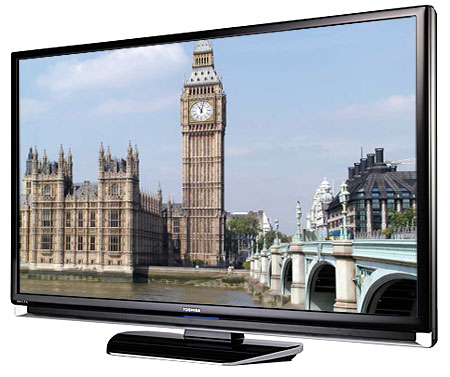Toshiba 52XF550U LCD TV

At the top of Toshiba's considerable LCD lineup is the 52XF550U, a 52-incher with 1920x1080 resolution and a super-skinny bezel that puts more emphasis on the video image and lets it fit in smaller spaces than models with more cabinetry around the screen. Is the image it produces worth all that attention? Let's find out...
Features
Like most high-end LCD TVs these days, the 52XF550U features 120Hz operation—frames are flashed on the screen at a rate of 120 per second, twice the normal video rate of 60Hz and five times the film frame rate of 24fps. In conjunction with ClearFrame—Toshiba's frame-interpolation algorithm—this is intended to reduce the motion blur that has plagued LCD TVs since their introduction.
Frame interpolation creates new frames to insert between the actual frames in a video signal, calculating where moving objects should be in those new frames to smooth out the motion and sharpen the image. However, this process can introduce artifacts of its own. Unlike many 120Hz LCD TVs, the 52XF550U's ClearFrame control has only two settings—On and Off. Such controls on other TVs typically offer different degrees of interpolation so you can balance the increased sharpness with any artifacts that might intrude.
Another feature related to movie playback is called Film Stabilization, which offers three settings: Standard, Smooth, and Off. Unfortunately, the manual does not explain what this control does, and Toshiba offered no details. Film Stabilization is only available if ClearFrame is on, but I didn't see any significant effect at any setting.
Color-point adjustment is becoming more common, and Toshiba's version is called ColorMaster. This lets you tweak the hue, saturation, and brightness of each primary (red, green, blue) and secondary (yellow, cyan, magenta) color, effectively moving the color points as needed. This is a great feature, but it should not be attempted without the requisite tools and training.
With three HDMI 1.3 inputs, the 52XF550U implements Consumer Electronics Control (CEC), which Toshiba calls REGZA Link. This sends control codes via HDMI to any compatible devices, turning them on and off and setting their inputs or outputs automatically as required. Interestingly, the TV recognized my Samsung BD-P1200 Blu-ray player via REGZA Link.
Other HDMI 1.3 features include Deep Color (increased color bit-depth) and x.v.Color (expanded color space), though no commercial titles are created using these enhanced specs. Some HD camcorders use Deep Color and x.v.Color, so the TV can display your own content from such a camcorder in its full glory. Of more importance is a lip-sync latency setting, which automatically delays the audio so it syncs up with the video. However, you must set these controls with no HDMI cable connected to the TV, which seems a bit strange.
As all 1080p displays should, this one has a 1:1 pixel-mapping mode for 1080i/p signals—it's the Native aspect-ratio setting. The manual says there's a Dot-by-Dot mode as well, but it's not visible when an HDMI or component input is selected; it's available only for the VGA input.





























































